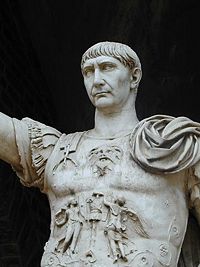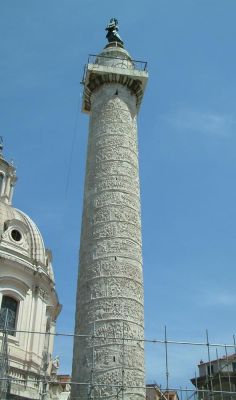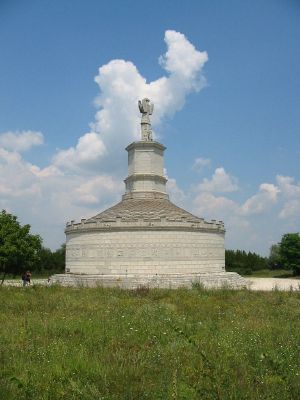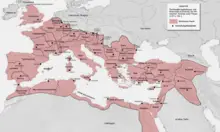Trajan
| Trajan | ||
|---|---|---|
| Emperor of the Roman Empire | ||

| ||
| Marble statue of Trajan at Colonia Ulpia Traiana (modern Xanten). | ||
| Reign | January 28, 98- August 9, 117 | |
| Full name | Marcus Ulpius Nerva Traianus | |
| Born | September 18, 53 | |
| Italica | ||
| Died | August 9, 117 | |
| Selinus | ||
| Buried | Rome (ashes in foot of Trajan's Column, now lost.) | |
| Predecessor | Nerva | |
| Successor | Hadrian | |
| Issue | Hadrian (adoptive) | |
| Father | Marcus Ulpius Traianus | |
| Mother | Marcia | |
| ||||||||||||||
- This article is about the Roman Emperor. For other meanings of "Traian", see Traian (disambiguation).
Marcus Ulpius Nerva Traianus, commonly called Trajan (September 18, 53–August 9, 117) was Roman Emperor in 98–117. He was the second of the Five Good Emperors of the Roman Empire. Under his rule, the Empire reached its greatest territorial extent.
Biography
Early life and rise to power
Trajan was the son of Marcia and Marcus Ulpius Traianus, a prominent senator and general from the famous gens Ulpia. The family had settled in Hispania (the Iberian Peninsula, comprising modern Spain and Portugal), in the province of Hispania Baetica in what is now Andalusia (in modern Spain), a province that was thoroughly Romanized and called southern Hispania. Trajan himself was just one of many well-known Ulpii in a line that continued long after his own death. His elder sister was Ulpia Marciana and his niece was Salonina Matidia.
He was born on September 18 53, in the city of Italica. As a young man, he rose through the ranks of the Roman army, serving in some of the most contentious parts of the Empire's frontier. In 76–77, Trajan's father was Governor of Syria (Legatus pro praetore Syriae), where Trajan himself remained as Tribunus legionis. Trajan was nominated as Consul and brought Apollodorus of Damascus with him to Rome around 91. Along the Rhine River, he took part in the Emperor Domitian's wars while under Domitian's successor, Nerva, who was unpopular with the army and needed to do something to gain their support. He accomplished this by naming Trajan as his adoptive son and successor in the summer of 97. According to the Augustan History, it was the future Emperor Hadrian who brought word to Trajan of his adoption.[1] When Nerva died on January 27 98, the highly respected Trajan succeeded without incident.
The new emperor was greeted by the people of Rome with great enthusiasm, which he justified by governing well and without the bloodiness that had marked Domitian's reign. He freed many people who had been unjustly imprisoned by Domitian and returned a great deal of private property that Domitian had confiscated; a process begun by Nerva before his death. His popularity was such that the Roman Senate eventually bestowed upon Trajan the honorific of optimus, meaning "the best."
Dio Cassius, sometimes known as Cassius Dio, reports that Trajan drank heavily and was a pederast. "I know, of course, that he was devoted to boys and to wine, but if he had ever committed or endured any base or wicked deed as the result of this, he would have incurred censure; as it was, however, he drank all the wine he wanted, yet remained sober, and in his relation with boys he harmed no one." (Dio Cassius, Epitome of Book LXVIII; 6.4) This sensibility was one that influenced even his governing, leading him to favour the king of Edessa out of appreciation for his handsome son: "On this occasion, however, Abgarus, induced partly by the persuasions of his son Arbandes, who was handsome and in the pride of youth and therefore in favour with Trajan, and partly by his fear of the latter's presence, he met him on the road, made his apologies and obtained pardon, for he had a powerful intercessor in the boy." (ibid. 21.2–3).
Dacian Wars
It was as a military commander that Trajan is best known to history. In 101, he launched a punitive expedition into the kingdom of Dacia, on the northern bank of the Danube River, defeating the Dacian army near Tapae. During the following winter Decebalus launched a counter-attack across the Danube further downstream, but this was repulsed. Trajan's army advanced further into Dacian territory and forced King Decebalus to submit to him a year later, after Trajan took the Dacian capital of Sarmizegethusa. Domitian had campaigned against Dacia from 85 to 89 without securing a decisive outcome, and Decebalus had brazenly flouted the terms of the peace which had been agreed on conclusion of this campaign.
Trajan now returned to Rome in triumph and was granted the title Dacicus Maximus. The victory was celebrated by the Tropaeum Traiani. Decebalus though, after being left to his own devices, in 105 undertook an invasion against Roman territory by attempting to stir up some of the tribes north of the river against her. Trajan took to the field again and after building with the design of Apollodorus of Damascus his massive bridge over the Danube, he conquered Dacia completely in 106. Sarmizegethusa was destroyed, Decebalus committed suicide, and his severed head was exhibited in Rome on the steps leading up to the Capitol. Trajan built a new city, "Colonia Ulpia Traiana Augusta Dacica Sarmizegethusa," on another site than the previous Dacian Capital, although bearing the same full name, Sarmizegethusa. He resettled Dacia with Romans and annexed it as a province of the Roman Empire. Trajan's Dacian campaigns benefited the Empire's finances through the acquisition of Dacia's gold mines. The victory is celebrated by Trajan's Column.
Expansion in the East
At about the same time, one of Rome's client kings, the last king of Nabatea, Rabbel II Soter, died. This might have prompted Trajan's annexation of Nabatea, although the reasons for annexation are not known, nor is the exact manner of annexation. Some epigraphic evidence suggests a military operation, with forces from Syria and Egypt. What is clear, however, is that by 107, Roman legions were stationed in the area around Petra and Bostra, as is shown by a papyrus found in Egypt. The Empire gained what became the province of Arabia Petraea (modern southern Jordan and north west Saudi Arabia).
Period of peace
The next seven years, Trajan ruled as a civilian emperor, to the same acclaim as before. It was during this time that he corresponded with Pliny the Younger on the subject of how to deal with the Christians of Pontus, telling Pliny to leave them alone unless they were openly practicing the religion. He built several new buildings, monuments and roads in Italia and his native Hispania. His magnificent complex in Rome raised to commemorate his victories in Dacia (and largely financed from that campaign's loot)—consisting of a forum, Trajan's Column, and a shopping centre—still stands in Rome today. He was also a prolific builder of triumphal arches, many of which survive, and rebuilder of roads (Via Traiana and Via Traiana Nova).
One notable act of Trajan was the hosting of a three-month gladiatorial festival in the great Colosseum in Rome (the precise date of this festival is unknown). Combining chariot racing, beast fights and close-quarters gladiatorial bloodshed, this gory spectacle reputedly left 11,000 dead (mostly slaves and criminals, not to mention the thousands of ferocious beasts killed alongside them) and attracted a total of five million spectators over the course of the festival.
Maximum extent of the Empire
In 113, he embarked on his last campaign, provoked by Parthia's decision to put an unacceptable king on the throne of Armenia, a kingdom over which the two great empires had shared hegemony since the time of Nero some fifty years earlier. Trajan marched first on Armenia, deposed the king and annexed it to the Roman Empire. Then he turned south into Parthia itself, taking the cities of Babylon, Seleucia and finally the capital of Ctesiphon in 116. He continued southward to the Persian Gulf, whence he declared Mesopotamia a new province of the Empire and lamented that he was too old to follow in the steps of Alexander the Great.
But he did not stop there. Later in 116, he captured the great city of Susa. He deposed the Parthian king Osroes I and put his own puppet ruler Parthamaspates on the throne. Never again would the Roman Empire advance so far to the east.
It was at this point that the fortunes of war—and his own health—betrayed Trajan. The fortress city of Hatra, on the Tigris in his rear, continued to hold out against repeated Roman assaults. He was personally present at the siege and it is possible that he suffered a heat stroke while in the blazing heat. The Jews inside the Roman Empire rose up in rebellion once more, as did the people of Mesopotamia. Trajan was forced to withdraw his army in order to put down the revolts. Trajan saw it as simply a temporary setback, but he was destined never to command an army in the field again, turning his Eastern armies over to the high ranking legate and governor of Judaea, Brinius Carnix Maximus.
Late in 116, Trajan grew ill and set out to sail back to Italy. His health declined throughout the spring and summer of 117, and by the time he had reached Selinus in Cilicia which was afterwards called Trajanopolis, he suddenly died from edema on August 9. Some say that he had adopted Hadrian as his successor, but others that it was his wife Pompeia Plotina who hired someone to impersonate him after he had died. Hadrian, upon becoming ruler, returned Mesopotamia to Parthian rule. However, all the other territories conquered by Trajan were retained. Trajan's ashes were laid to rest underneath Trajan's column, the monument commemorating his success.
Trajan's legacy

For the remainder of the history of the Roman Empire and well into the era of the Byzantine Empire, every new emperor after Trajan was honoured by the Senate with the prayer felicior Augusto, melior Traiano, meaning "may he be luckier than Augustus and better than Trajan."
Unlike many lauded rulers in history, Trajan's reputation has survived undiminished for nearly nineteen centuries. The Christianization of Rome resulted in further embellishment of his legend: it was commonly said in medieval times that Pope Gregory I, through divine intercession, resurrected Trajan from the dead and baptized him into the Christian faith. An account of this features in the Golden Legend. Theologians, such as Thomas Aquinas, discussed Trajan as an example of a virtuous pagan. In the Divine Comedy, Dante, following this legend, sees the spirit of Trajan in the Heaven of Jupiter with other historical and mythological persons noted for their justice. He also features in Piers Plowman. An episode, referred to as the justice of Trajan was reflected in several art works.
See also
- Trajan's Market
- Trophaeum Traiani
- Trajan's Column
- Trajan's bridge
Notes
References and further reading
- Ancell, R. Manning. "Soldiers." Military Heritage. December 2001. Volume 3, No. 3: 12, 14, 16, 20 (Trajan, Emperor of Rome).
- Bennett, J. Trajan: Optimus Princeps, 2nd Edition, Routledge 2001
- Bowersock, G.W. Roman Arabia, Harvard University Press, 1983
- Fuller, J.F.C. A Military History of the Western World. Three Volumes. New York: Da Capo Press, Inc., 1987 and 1988.
- v. 1. From the earliest times to the Battle of Lepanto; ISBN 0-306-80304-6: 255, 266, 269, 270, 273 (Trajan, Roman Emperor).
- Isaac, B. The Limits of Empire, The Roman Army in the East, Revised Edition, Oxford University Press, 1990
- Kennedy, D. The Roman Army in Jordan, Revised Edition, Council for British Research in the Levant, 2004
- Lepper, F.A. Trajan's Parthian War. London: Oxford University Press, 1948.
| Preceded by: Domitian and Marcus Cocceius Nerva |
Consul of the Roman Empire with Manius Acilius Glabrio 91 |
Succeeded by: Domitian and Quintus Volusius Saturninus |
| Preceded by: Marcus Cocceius Nerva and Lucius Verginius Rufus |
Consul of the Roman Empire with Nerva 98 |
Succeeded by: Aulus Cornelius Palma Frontonianus and Quintus Sosius Senecio Template:Succession box four to four |
| Preceded by: Aulus Cornelius Palma Frontonianus and Quintus Sosius Senecio |
Consul of the Roman Empire 100–101 |
Succeeded by: Lucius Iulius Ursus Servianus and Lucius Licinius Sura |
| Preceded by: Lucius Iulius Ursus Servianus and Lucius Licinius Sura |
Consul of the Roman Empire with Marcus Laberius Maximus 103 |
Succeeded by: Sextus Attius Suburanus Aemilianus and Marcus Asinius Marcellus |
| Preceded by: Gaius Calpurnius Piso and Marcus Vettius Bolanus |
Consul of the Roman Empire with Titus Sextius Africanus 112 |
Succeeded by: Lucius Publilius Celsus and Gaius Clodius Crispinus |
| Five Good Emperors |
|---|
| Nerva • Trajan • Hadrian • Antoninus Pius • Marcus Aurelius |
| Roman Emperors | |||||||||||||||||
|---|---|---|---|---|---|---|---|---|---|---|---|---|---|---|---|---|---|
| Principate 27 B.C.E. - 235 C.E. |
Augustus · Tiberius · Caligula · Claudius I · Nero · Galba · Otho · Vitellius · Vespasian · Titus · Domitian · Nerva · Trajan · Hadrian · Antoninus Pius · Marcus Aurelius · Lucius Verus · Commodus · Pertinax · Didius Julianus · Septimius Severus · Caracalla · Macrinus · Elagabalus · Alexander Severus | ||||||||||||||||
| Crisis 235 C.E. - 284 C.E. |
Maximinus Thrax · Gordian I · Gordian II · Pupienus and Balbinus · Gordian III · Philip the Arab · Decius · Trebonianus Gallus · Aemilianus · Valerian · Gallienus · Claudius II · Quintillus · Aurelian · Marcus Claudius Tacitus · Florianus · Probus · Carus · Numerian · Carinus | ||||||||||||||||
| Dominate |
| ||||||||||||||||
be-x-old:Марк Ульпій Траян sh:Trajan
Credits
New World Encyclopedia writers and editors rewrote and completed the Wikipedia article in accordance with New World Encyclopedia standards. This article abides by terms of the Creative Commons CC-by-sa 3.0 License (CC-by-sa), which may be used and disseminated with proper attribution. Credit is due under the terms of this license that can reference both the New World Encyclopedia contributors and the selfless volunteer contributors of the Wikimedia Foundation. To cite this article click here for a list of acceptable citing formats.The history of earlier contributions by wikipedians is accessible to researchers here:
The history of this article since it was imported to New World Encyclopedia:
Note: Some restrictions may apply to use of individual images which are separately licensed.




